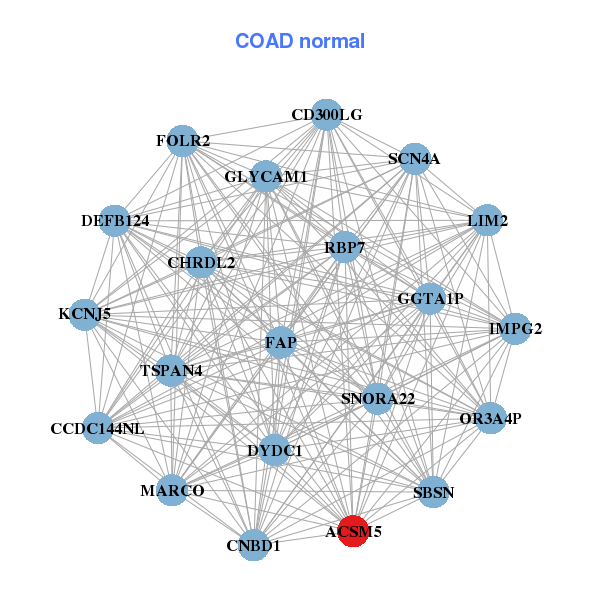|
||||||||||||||||||||||||||||||||||||||||||||||||||||||||||||||||||||||||||||||||||||||||||||||||||||||||||||||||||||||||||||||||||||||||||||||||||||||||||||||||||||||||||||||||||||||||||||||||||||||||||||||||||||||||||||||||||||||||||||||||||||||||||||||||||||||||||||||||||||||||||||||||||||||||||||||||||||||||||
| |
| Phenotypic Information (metabolism pathway, cancer, disease, phenome) |
| |
| |
| Gene-Gene Network Information: Co-Expression Network, Interacting Genes & KEGG |
| |
|
| Gene Summary for ACSM5 |
| Basic gene info. | Gene symbol | ACSM5 |
| Gene name | acyl-CoA synthetase medium-chain family member 5 | |
| Synonyms | - | |
| Cytomap | UCSC genome browser: 16p12.3 | |
| Genomic location | chr16 :20420855-20452281 | |
| Type of gene | protein-coding | |
| RefGenes | NM_017888.2, | |
| Ensembl id | ENSG00000183549 | |
| Description | acyl-coenzyme A synthetase ACSM5, mitochondrial | |
| Modification date | 20141211 | |
| dbXrefs | MIM : 614361 | |
| HGNC : HGNC | ||
| Ensembl : ENSG00000183549 | ||
| HPRD : 08627 | ||
| Vega : OTTHUMG00000131551 | ||
| Protein | UniProt: go to UniProt's Cross Reference DB Table | |
| Expression | CleanEX: HS_ACSM5 | |
| BioGPS: 54988 | ||
| Gene Expression Atlas: ENSG00000183549 | ||
| The Human Protein Atlas: ENSG00000183549 | ||
| Pathway | NCI Pathway Interaction Database: ACSM5 | |
| KEGG: ACSM5 | ||
| REACTOME: ACSM5 | ||
| ConsensusPathDB | ||
| Pathway Commons: ACSM5 | ||
| Metabolism | MetaCyc: ACSM5 | |
| HUMANCyc: ACSM5 | ||
| Regulation | Ensembl's Regulation: ENSG00000183549 | |
| miRBase: chr16 :20,420,855-20,452,281 | ||
| TargetScan: NM_017888 | ||
| cisRED: ENSG00000183549 | ||
| Context | iHOP: ACSM5 | |
| cancer metabolism search in PubMed: ACSM5 | ||
| UCL Cancer Institute: ACSM5 | ||
| Assigned class in ccmGDB | C | |
| Top |
| Phenotypic Information for ACSM5(metabolism pathway, cancer, disease, phenome) |
| Cancer | CGAP: ACSM5 |
| Familial Cancer Database: ACSM5 | |
| * This gene is included in those cancer gene databases. |
|
|
|
|
|
| . | ||||||||||||||||||||||||||||||||||||||||||||||||||||||||||||||||||||||||||||||||||||||||||||||||||||||||||||||||||||||||||||||||||||||||||||||||||||||||||||||||||||||||||||||||||||||||||||||||||||||||||||||||||||||||||||||||||||||||||||||||||||||||||||||||||||||||||||||||||||||||||||||||||||||||||||||||||||
Oncogene 1 | Significant driver gene in | |||||||||||||||||||||||||||||||||||||||||||||||||||||||||||||||||||||||||||||||||||||||||||||||||||||||||||||||||||||||||||||||||||||||||||||||||||||||||||||||||||||||||||||||||||||||||||||||||||||||||||||||||||||||||||||||||||||||||||||||||||||||||||||||||||||||||||||||||||||||||||||||||||||||||||||||||||||||||
| cf) number; DB name 1 Oncogene; http://nar.oxfordjournals.org/content/35/suppl_1/D721.long, 2 Tumor Suppressor gene; https://bioinfo.uth.edu/TSGene/, 3 Cancer Gene Census; http://www.nature.com/nrc/journal/v4/n3/abs/nrc1299.html, 4 CancerGenes; http://nar.oxfordjournals.org/content/35/suppl_1/D721.long, 5 Network of Cancer Gene; http://ncg.kcl.ac.uk/index.php, 1Therapeutic Vulnerabilities in Cancer; http://cbio.mskcc.org/cancergenomics/statius/ |
| KEGG_BUTANOATE_METABOLISM | |
| OMIM | |
| Orphanet | |
| Disease | KEGG Disease: ACSM5 |
| MedGen: ACSM5 (Human Medical Genetics with Condition) | |
| ClinVar: ACSM5 | |
| Phenotype | MGI: ACSM5 (International Mouse Phenotyping Consortium) |
| PhenomicDB: ACSM5 | |
| Mutations for ACSM5 |
| * Under tables are showing count per each tissue to give us broad intuition about tissue specific mutation patterns.You can go to the detailed page for each mutation database's web site. |
| There's no structural variation information in COSMIC data for this gene. |
| * From mRNA Sanger sequences, Chitars2.0 arranged chimeric transcripts. This table shows ACSM5 related fusion information. |
| ID | Head Gene | Tail Gene | Accession | Gene_a | qStart_a | qEnd_a | Chromosome_a | tStart_a | tEnd_a | Gene_a | qStart_a | qEnd_a | Chromosome_a | tStart_a | tEnd_a |
| Top |
| Mutation type/ Tissue ID | brca | cns | cerv | endome | haematopo | kidn | Lintest | liver | lung | ns | ovary | pancre | prost | skin | stoma | thyro | urina | |||
| Total # sample | 1 | |||||||||||||||||||
| GAIN (# sample) | 1 | |||||||||||||||||||
| LOSS (# sample) |
| cf) Tissue ID; Tissue type (1; Breast, 2; Central_nervous_system, 3; Cervix, 4; Endometrium, 5; Haematopoietic_and_lymphoid_tissue, 6; Kidney, 7; Large_intestine, 8; Liver, 9; Lung, 10; NS, 11; Ovary, 12; Pancreas, 13; Prostate, 14; Skin, 15; Stomach, 16; Thyroid, 17; Urinary_tract) |
| Top |
|
 |
| Top |
| Stat. for Non-Synonymous SNVs (# total SNVs=80) | (# total SNVs=29) |
 | 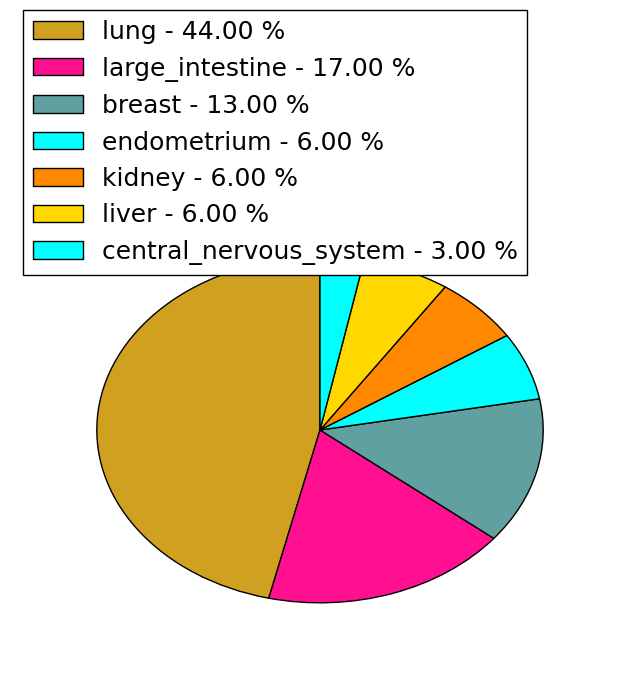 |
(# total SNVs=0) | (# total SNVs=0) |
| Top |
| * When you move the cursor on each content, you can see more deailed mutation information on the Tooltip. Those are primary_site,primary_histology,mutation(aa),pubmedID. |
| GRCh37 position | Mutation(aa) | Unique sampleID count |
| chr16:20442562-20442562 | p.N409N | 4 |
| chr16:20442344-20442344 | p.M385I | 3 |
| chr16:20442608-20442608 | p.P425T | 3 |
| chr16:20442613-20442613 | p.T426T | 3 |
| chr16:20451726-20451726 | p.R573* | 2 |
| chr16:20430630-20430630 | p.I166V | 2 |
| chr16:20429585-20429585 | p.R137W | 2 |
| chr16:20448643-20448643 | p.V497A | 2 |
| chr16:20442358-20442358 | p.G390E | 2 |
| chr16:20429402-20429402 | p.P76S | 2 |
| Top |
|
 |
| Point Mutation/ Tissue ID | 1 | 2 | 3 | 4 | 5 | 6 | 7 | 8 | 9 | 10 | 11 | 12 | 13 | 14 | 15 | 16 | 17 | 18 | 19 | 20 |
| # sample | 1 | 3 | 8 | 2 | 8 | 1 | 27 | 11 | 2 | 21 | 2 | 1 | 9 | |||||||
| # mutation | 1 | 3 | 8 | 2 | 8 | 1 | 27 | 11 | 3 | 25 | 2 | 1 | 9 | |||||||
| nonsynonymous SNV | 1 | 2 | 6 | 1 | 5 | 1 | 16 | 6 | 3 | 14 | 1 | 1 | 7 | |||||||
| synonymous SNV | 1 | 2 | 1 | 3 | 11 | 5 | 11 | 1 | 2 |
| cf) Tissue ID; Tissue type (1; BLCA[Bladder Urothelial Carcinoma], 2; BRCA[Breast invasive carcinoma], 3; CESC[Cervical squamous cell carcinoma and endocervical adenocarcinoma], 4; COAD[Colon adenocarcinoma], 5; GBM[Glioblastoma multiforme], 6; Glioma Low Grade, 7; HNSC[Head and Neck squamous cell carcinoma], 8; KICH[Kidney Chromophobe], 9; KIRC[Kidney renal clear cell carcinoma], 10; KIRP[Kidney renal papillary cell carcinoma], 11; LAML[Acute Myeloid Leukemia], 12; LUAD[Lung adenocarcinoma], 13; LUSC[Lung squamous cell carcinoma], 14; OV[Ovarian serous cystadenocarcinoma ], 15; PAAD[Pancreatic adenocarcinoma], 16; PRAD[Prostate adenocarcinoma], 17; SKCM[Skin Cutaneous Melanoma], 18:STAD[Stomach adenocarcinoma], 19:THCA[Thyroid carcinoma], 20:UCEC[Uterine Corpus Endometrial Carcinoma]) |
| Top |
| * We represented just top 10 SNVs. When you move the cursor on each content, you can see more deailed mutation information on the Tooltip. Those are primary_site, primary_histology, mutation(aa), pubmedID. |
| Genomic Position | Mutation(aa) | Unique sampleID count |
| chr16:20442600 | p.R422H | 2 |
| chr16:20422911 | p.V497A | 2 |
| chr16:20448643 | p.I35I | 2 |
| chr16:20429402 | p.P76T | 2 |
| chr16:20448652 | p.G417E | 1 |
| chr16:20430623 | p.I482I | 1 |
| chr16:20441026 | p.S564S | 1 |
| chr16:20451701 | p.R137W | 1 |
| chr16:20432639 | p.Y228C | 1 |
| chr16:20442585 | p.P321S | 1 |
| * Copy number data were extracted from TCGA using R package TCGA-Assembler. The URLs of all public data files on TCGA DCC data server were gathered on Jan-05-2015. Function ProcessCNAData in TCGA-Assembler package was used to obtain gene-level copy number value which is calculated as the average copy number of the genomic region of a gene. |
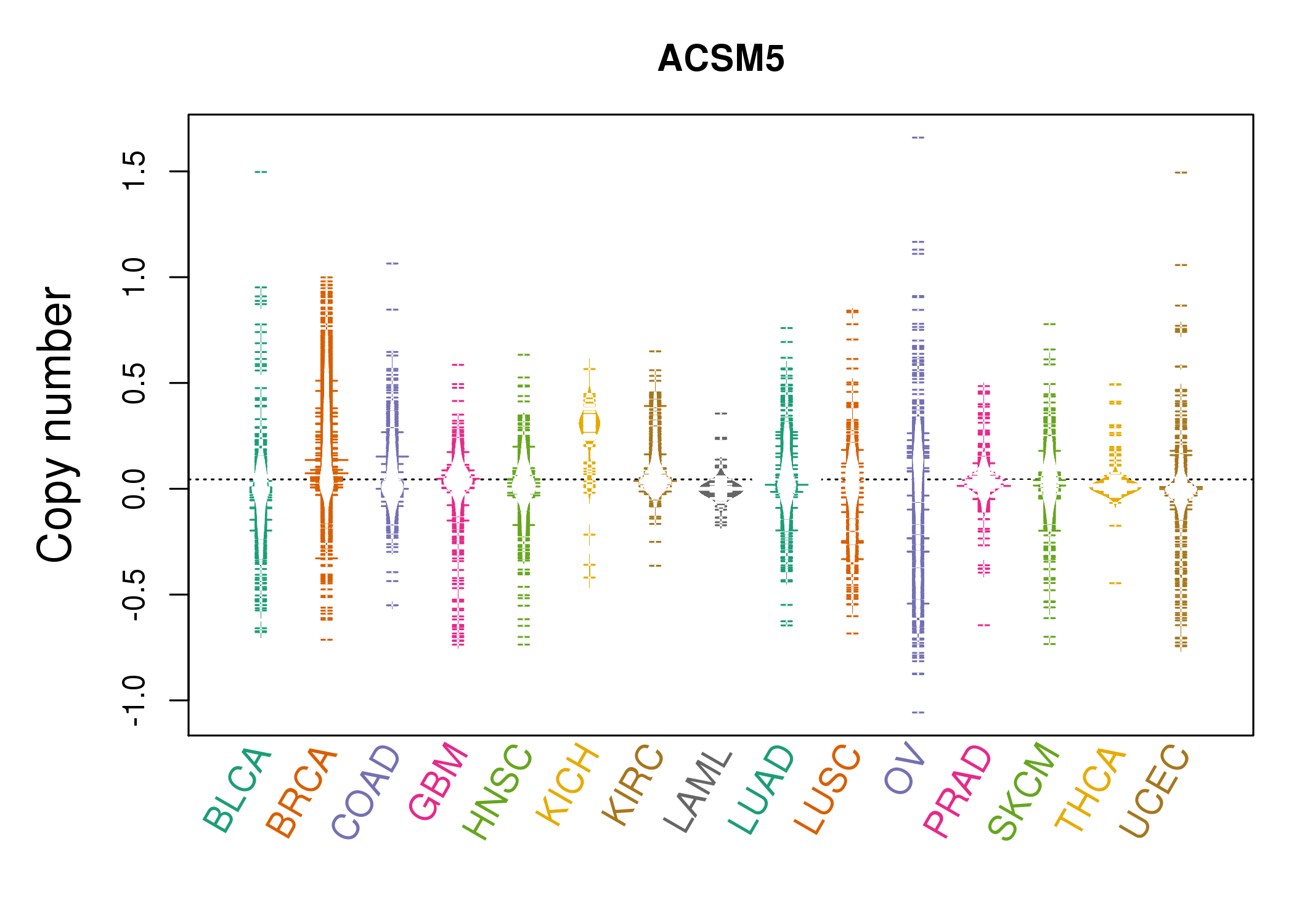 |
| cf) Tissue ID[Tissue type]: BLCA[Bladder Urothelial Carcinoma], BRCA[Breast invasive carcinoma], CESC[Cervical squamous cell carcinoma and endocervical adenocarcinoma], COAD[Colon adenocarcinoma], GBM[Glioblastoma multiforme], Glioma Low Grade, HNSC[Head and Neck squamous cell carcinoma], KICH[Kidney Chromophobe], KIRC[Kidney renal clear cell carcinoma], KIRP[Kidney renal papillary cell carcinoma], LAML[Acute Myeloid Leukemia], LUAD[Lung adenocarcinoma], LUSC[Lung squamous cell carcinoma], OV[Ovarian serous cystadenocarcinoma ], PAAD[Pancreatic adenocarcinoma], PRAD[Prostate adenocarcinoma], SKCM[Skin Cutaneous Melanoma], STAD[Stomach adenocarcinoma], THCA[Thyroid carcinoma], UCEC[Uterine Corpus Endometrial Carcinoma] |
| Top |
| Gene Expression for ACSM5 |
| * CCLE gene expression data were extracted from CCLE_Expression_Entrez_2012-10-18.res: Gene-centric RMA-normalized mRNA expression data. |
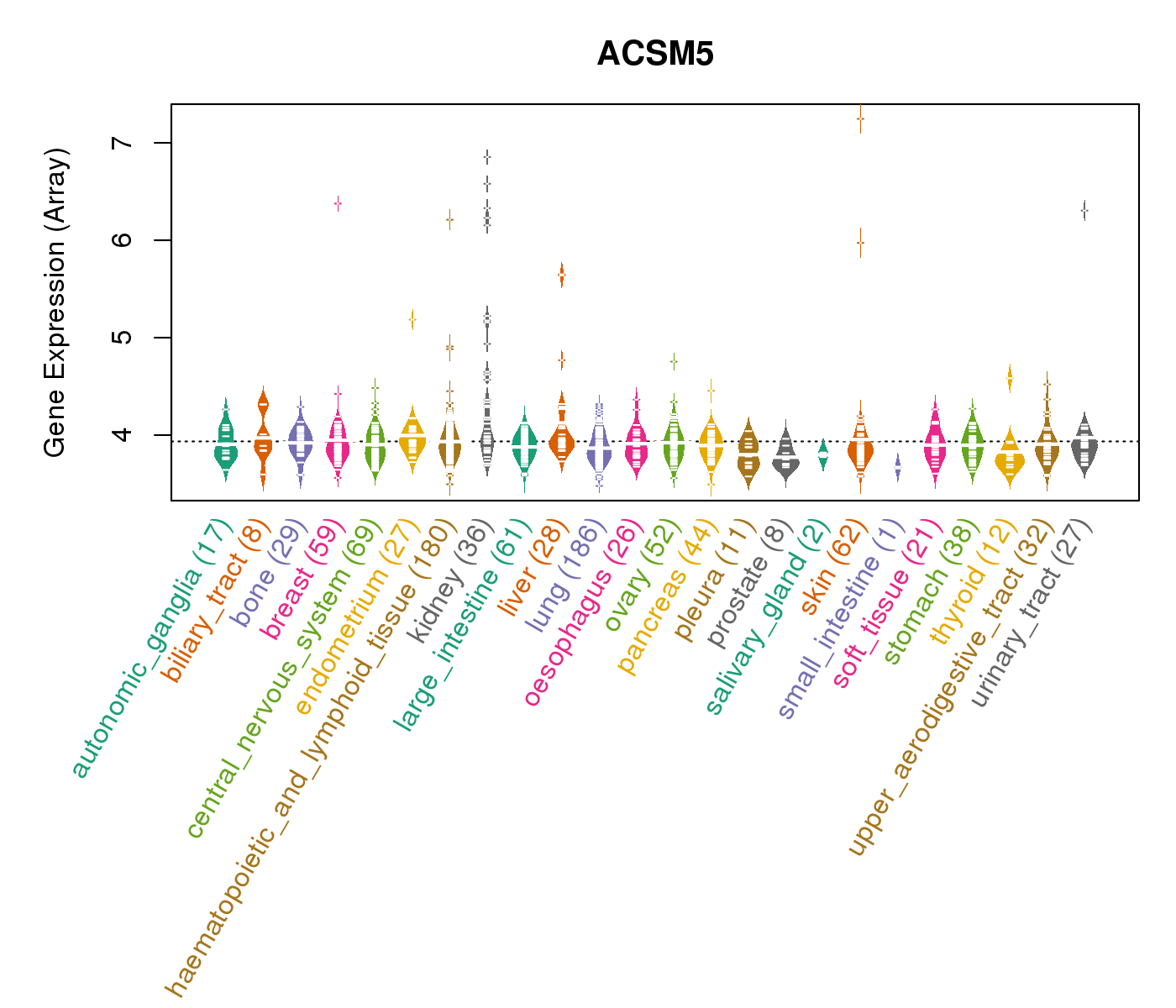 |
| * Normalized gene expression data of RNASeqV2 was extracted from TCGA using R package TCGA-Assembler. The URLs of all public data files on TCGA DCC data server were gathered at Jan-05-2015. Only eight cancer types have enough normal control samples for differential expression analysis. (t test, adjusted p<0.05 (using Benjamini-Hochberg FDR)) |
 |
| Top |
| * This plots show the correlation between CNV and gene expression. |
: Open all plots for all cancer types
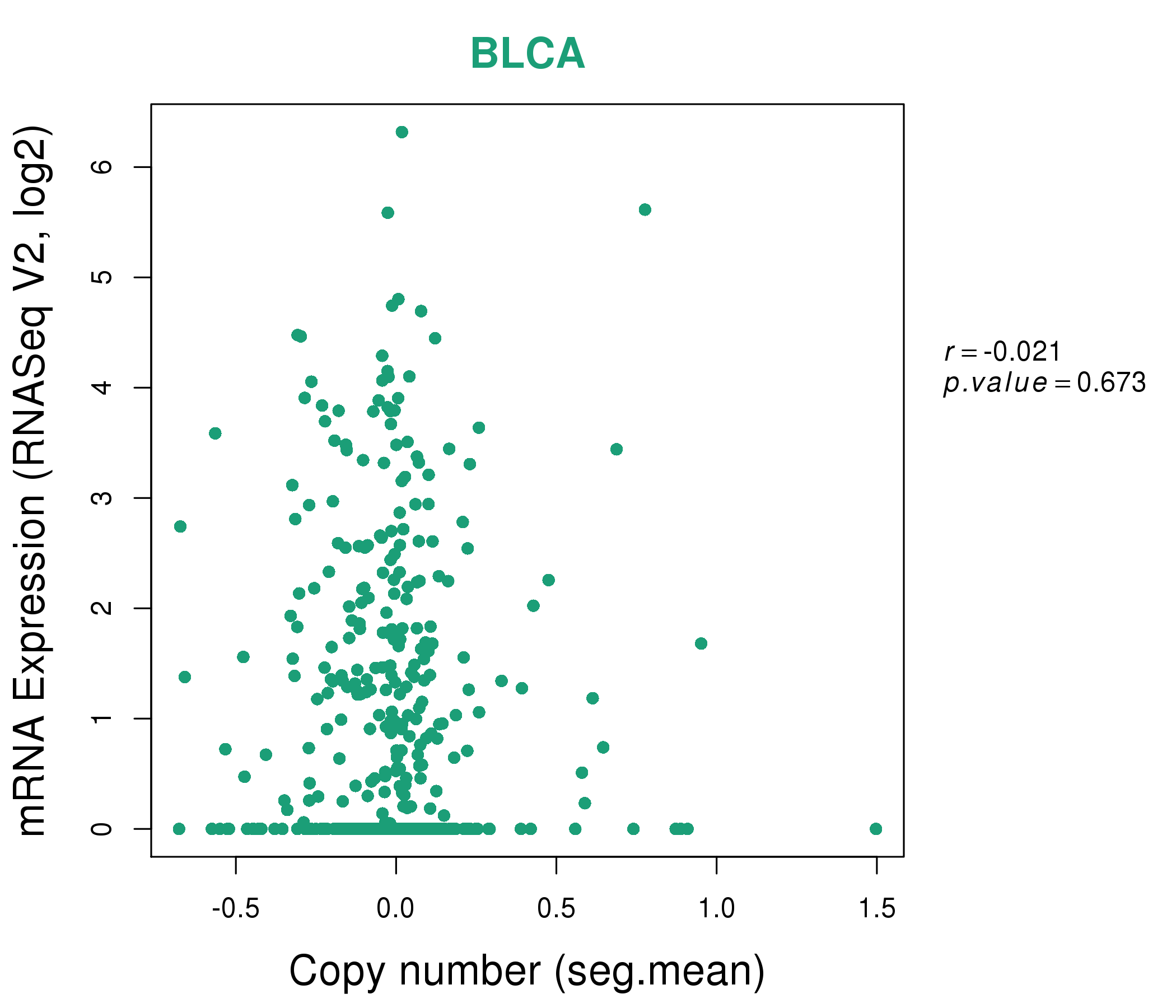 |
|
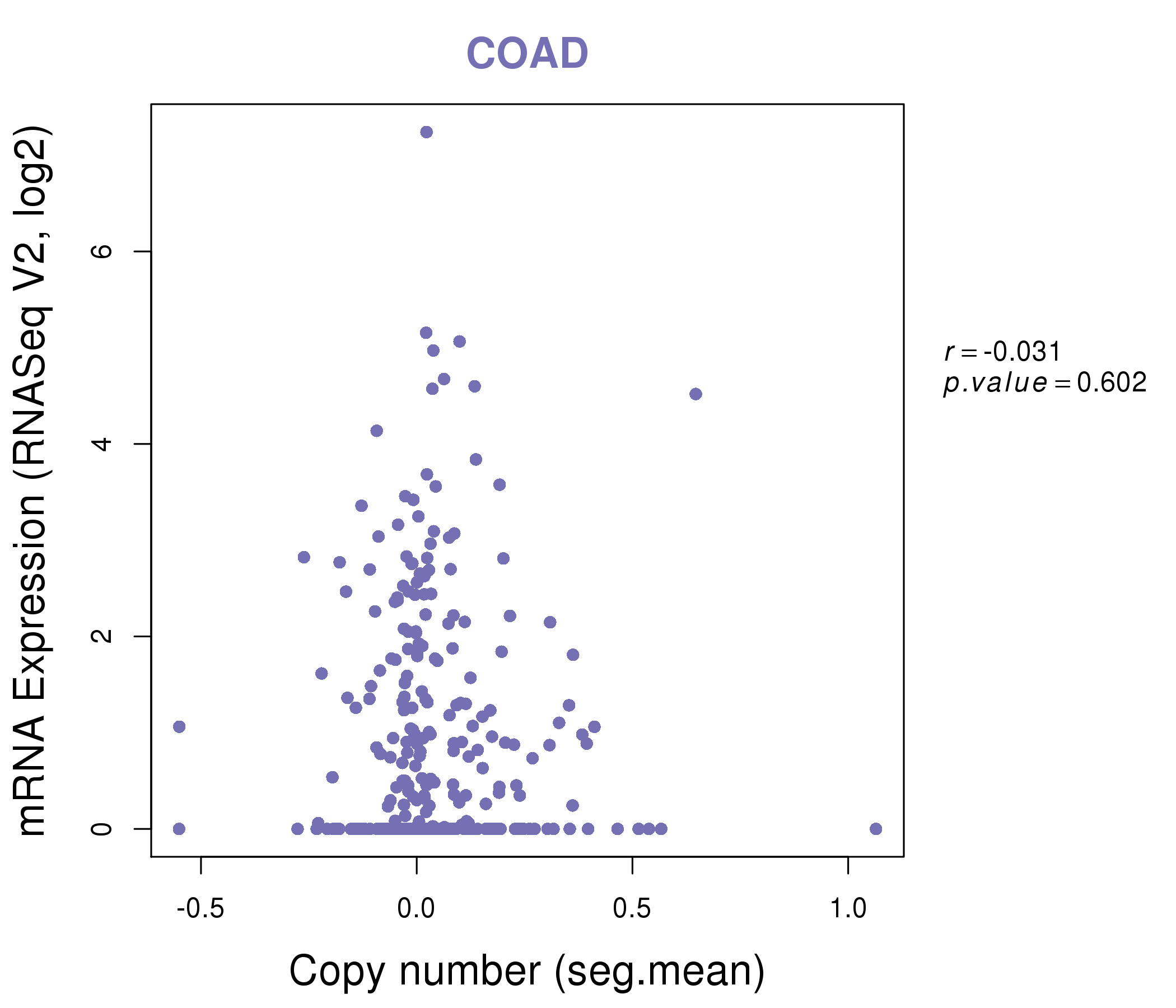 |
|
| Top |
| Gene-Gene Network Information |
| * Co-Expression network figures were drawn using R package igraph. Only the top 20 genes with the highest correlations were shown. Red circle: input gene, orange circle: cell metabolism gene, sky circle: other gene |
: Open all plots for all cancer types
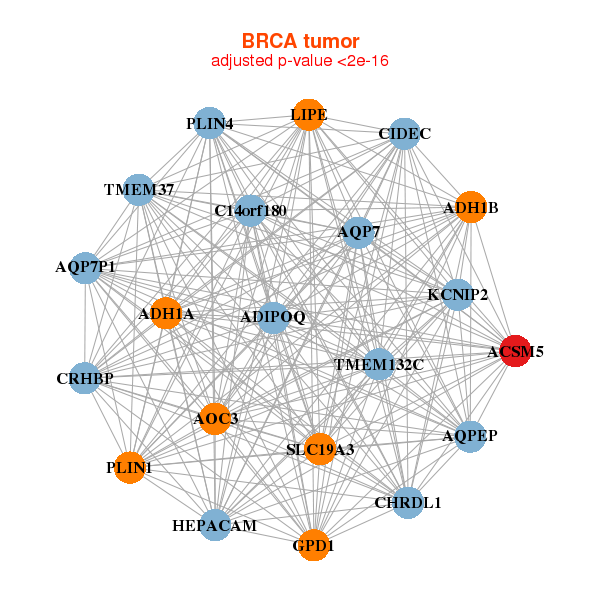 |
|
| ACSM5,ADH1A,ADH1B,ADIPOQ,AOC3,AQP7,AQP7P1, AQPEP,C14orf180,CHRDL1,CIDEC,CRHBP,GPD1,HEPACAM, KCNIP2,LIPE,PLIN1,PLIN4,SLC19A3,TMEM132C,TMEM37 | ABHD15,ACO1,ACSM5,ALDH2,AOC3,AQP7,FAM213A, CIDEC,CPM,FAH,FBXO27,GYG2,HEPACAM,MAOA, PLA2G16,PLIN1,RDH5,RHOBTB3,SH3KBP1,TMEM132C,TYRO3 |
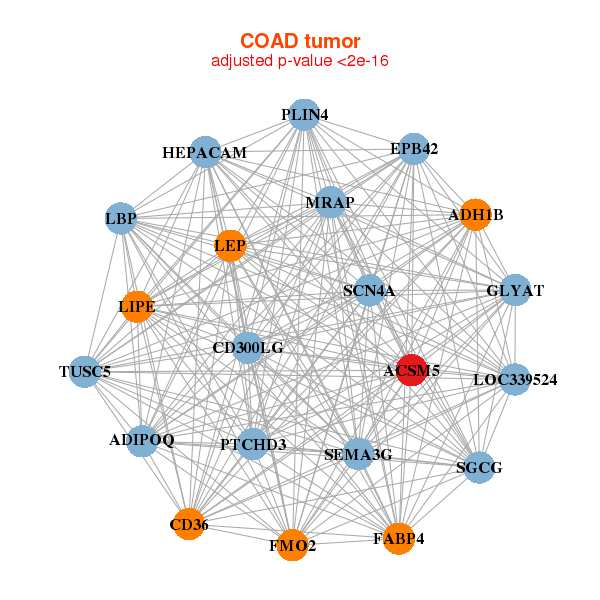 |
|
| ACSM5,ADH1B,ADIPOQ,CD300LG,CD36,EPB42,FABP4, FMO2,GLYAT,HEPACAM,LBP,LEP,LIPE,LOC339524, MRAP,PLIN4,PTCHD3,SCN4A,SEMA3G,SGCG,TUSC5 | ACSM5,CCDC144NL,CD300LG,CHRDL2,CNBD1,DEFB124,DYDC1, FAP,FOLR2,GGTA1P,GLYCAM1,IMPG2,KCNJ5,LIM2, MARCO,OR3A4P,RBP7,SBSN,SCN4A,SNORA22,TSPAN4 |
| * Co-Expression network figures were drawn using R package igraph. Only the top 20 genes with the highest correlations were shown. Red circle: input gene, orange circle: cell metabolism gene, sky circle: other gene |
: Open all plots for all cancer types
| Top |
: Open all interacting genes' information including KEGG pathway for all interacting genes from DAVID
| Top |
| Pharmacological Information for ACSM5 |
| There's no related Drug. |
| Top |
| Cross referenced IDs for ACSM5 |
| * We obtained these cross-references from Uniprot database. It covers 150 different DBs, 18 categories. http://www.uniprot.org/help/cross_references_section |
: Open all cross reference information
|
Copyright © 2016-Present - The Univsersity of Texas Health Science Center at Houston @ |









